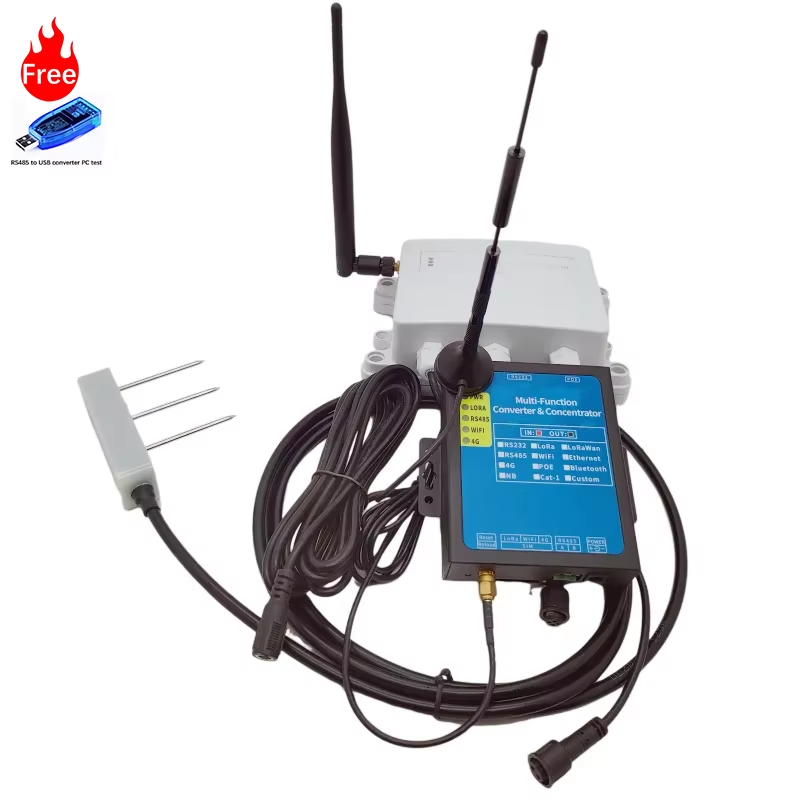Katika maendeleo ya haraka ya kilimo cha usahihi nchini Marekani, kihisi cha udongo cha Teros 12 kimekuwa chombo cha msingi kwa mashamba ya mashambani, taasisi za utafiti wa kisayansi na mifumo mahiri ya umwagiliaji maji yenye usahihi wa hali ya juu, uimara na uwezo wake wa kusambaza bila waya.
Faida kuu:
Ufuatiliaji wa vigezo vingi: kipimo cha usawazishaji cha unyevu wa udongo, halijoto, na upitishaji umeme (EC)
Uimara wa kiwango cha viwanda: Ulinzi wa IP68, operesheni thabiti katika mazingira ya hali ya juu ya -40°C~60°C
Utangamano usio na mshono: msaada kwa itifaki nyingi za upitishaji data kama vile LoRaWAN na SDI-12
Makala haya yanachanganua jinsi Teros 12 inavyobadilisha mbinu ya kufanya maamuzi ya kilimo cha Marekani kupitia kesi 3 za kawaida za utumaji maombi.
Uchambuzi wa kesi ya kawaida
Uchunguzi wa 1: Umwagiliaji kwa usahihi wa bustani za mlozi katika Bonde la Kati la California
Usuli
Tatizo: Sera ya ukame ya California inazuia matumizi ya maji, na mbinu za umwagiliaji wa jadi husababisha mkazo wa maji katika miti ya mlozi, na kupunguza uzalishaji kwa 15% ~ 20%.
Suluhisho: Tumia jukwaa la Wingu la Teros 12 + ZENTRA kila ekari 40 ili kufuatilia mienendo ya maji ya eneo la mizizi kwa wakati halisi.
Athari
Kuokoa maji 22% (akiba ya kila mwaka ya bili ya maji ya $ 18,000)
Mavuno ya mlozi yaliongezeka kwa 12% (chanzo cha data: Utafiti wa UC Davis 2023)
Kesi ya 2: Iowa - Uboreshaji wa mbolea ya nitrojeni katika mashamba ya mzunguko wa mahindi na soya
Usuli
Changamoto: Urutubishaji wa kiasili unategemea mfumo wa kalenda, na kiwango cha matumizi ya mbolea ya nitrojeni cha 30% ~ 40% tu, na uchafuzi mkubwa wa uvujaji.
Suluhisho bunifu: Tabiri mahitaji ya nitrojeni kupitia data ya EC ya udongo ya Teros 12 pamoja na muundo wa AI.
Matokeo
Kupunguza matumizi ya mbolea ya nitrojeni kwa 25%, na mavuno ya mahindi yaliongezeka kwa 8% (data ya majaribio kutoka Chuo Kikuu cha Jimbo la Iowa)
Imepokea bonasi ya USDA ya Motisha ya Ubora wa Mazingira (EQIP) ya $12,000/shamba
Uchunguzi wa 3: Arizona - Ufuatiliaji wa kilimo kisicho na udongo cha nyanya za chafu
Pointi za maumivu
Katika kilimo cha matawi ya nazi, ugunduzi wa pH na EC kwa mikono unatumia muda mwingi na unacheleweshwa, na hivyo kusababisha kushuka kwa ubora.
Suluhisho la kiufundi: Teros 12 hupachikwa kwenye tanki la kilimo na hupakia data kwenye jukwaa kila baada ya dakika 15.
Faida
Gharama za kazi zimepunguzwa kwa 40%
Maudhui ya sukari ya nyanya ni thabiti kwa zaidi ya 7.2°Brix (kulingana na viwango vya ununuzi wa Whole Foods)
Utendaji wa kiufundi
Usahihi wa kipimo: ±3% VWC (0~50%)
Itifaki ya mawasiliano: LoRaWAN/SDI-12
Kiwango cha ulinzi: IP68 (inaweza kuzikwa kwa miaka 10), IP67 (inapendekezwa kubadilishwa kila baada ya miaka 1~3)
Kumbuka: Teknolojia ya Teros 12's TDR (reflectometry ya kikoa cha wakati) ni sugu zaidi kwa kuingiliwa kwa chumvi kuliko vitambuzi vya capacitive.
Umaarufu wa Teros 12 unaashiria mabadiliko ya kilimo cha Amerika kutoka kwa uzoefu hadi kuendeshwa na data:
Wakulima: punguza upotevu wa rasilimali na kuboresha uzingatiaji (kama vile Sheria ya Maji ya Chini ya California ya SGMA)
Taasisi za utafiti wa kisayansi: pata seti za data za muda mrefu ili kuharakisha uteuzi wa anuwai
Fedha za Kilimo: bima na mikopo huanza kukubali data ya kitambuzi kama msingi wa tathmini ya hatari
Kwa maelezo zaidi ya kituo cha hali ya hewa, tafadhali wasiliana na Honde Technology Co., LTD.
Simu: +86-15210548582
Email: info@hondetech.com
Tovuti ya kampuni:www.hondetechco.com
Muda wa kutuma: Juni-13-2025


